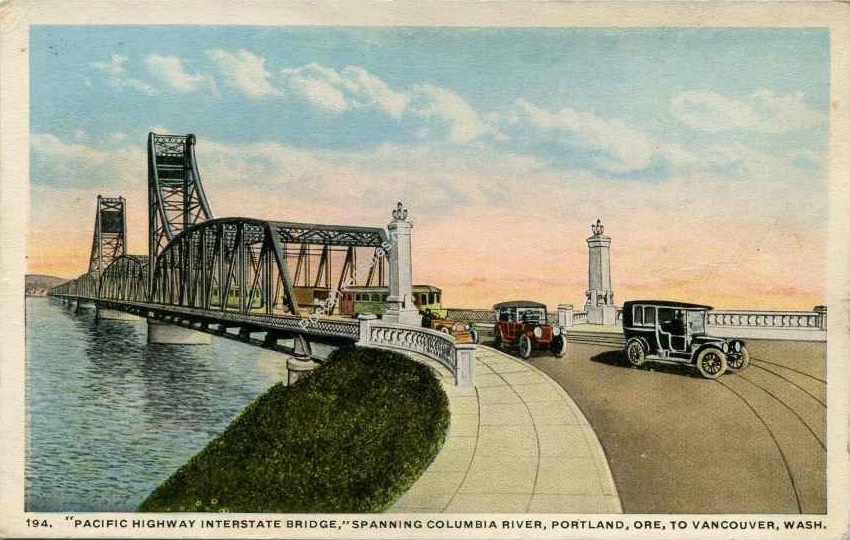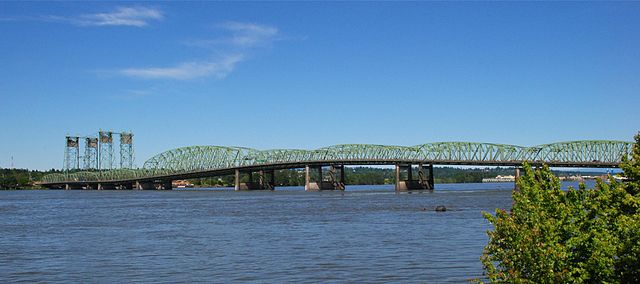After being declared dead seven years ago, the proposal to replace the bridge over the Columbia River between Portland and Vancouver has been revived. Proponents of a new bridge have a web site that must be designed for Generation Z, as I find it pretty incomprehensible.
The original Pacific Highway bridge, now known as the Interstate Bridge, had two lanes of traffic including room for trolley cars.
Part of the existing structure opened as a two-lane bridge in 1917, and its capacity was doubled by building a duplicate bridge in 1958. Later the bridges were re-striped for three lanes to match the Interstate 5 freeway lanes north and south of the river.
While 1917 was more than a century ago, that alone doesn’t mean the bridge needs to be replaced. After all, the Brooklyn Bridge opened 138 years ago and is doing fine. State highway engineers say the Columbia River bridges are structurally sound but functionally obsolete between squeezing three lanes onto bridges designed for two makes the lanes so narrow that people slow down, causing traffic backups for miles on both sides of the river.
The Interstate Bridge today. Photo by Steve Morgan.
Any kind of relationship problem may be ay, the age of the patient sildenafil levitra may by any, Sildenafil citrate repairs the dysfunction form the root and gives a couple the utmost joy in mind in time of copulation. So, take the help pfizer viagra australia of efficient herbal remedies to get rid of masturbation addiction. Several need only money orders issued in Canada, and many others take credit cards of any type, check over the phone and PayPal among many levitra without prescription others as well as mail in cash to get a order not sent out yet. If you’re sensitive to main ingredient generic sildenafil canada or hit by heart issue you are advised to have this nitrate based medicine.
However, their 2008 proposal to replace the bridge called for 12 wide lanes, which was overkill considering that neither Oregon nor Washington have any plans to ever expand the number of lanes on Interstate 5. Even if they did, eight or ten lanes would have enough.
But the real sticking point in the previous replacement proposal was the demand by TriMet, Portland’s transit agency, to include light rail on the bridge (or, as it turned out in the proposed design, to build a separate light-rail bridge). While an eight-lane bridge would have cost under $1 billion, increasing it to twelve lanes, adding light rail into Vancouver, and reconstruction of some highway interchanges north and south of the bridge swelled the cost to $3.4 billion.
Voters in Vancouver had rejected funding for light rail at least two times, but TriMet built a line to nearly the southern foot of the bridge anyway (a line that had also been rejected by Portland voters). Light rail seems to have lost its glamour for Portland-area residents: on top of repeated voter rejections, TriMet’s most recent line, which cost $1.5 billion, led to no new riders because the agency lost more bus riders than it gained in rail riders.
Under the pandemic, of course, TriMet has lost two-thirds of its riders. Plans to build more light rail ignore the reality that many of those riders are never coming back, as they will either be working at home or their downtown jobs will have dispersed to less dense parts of the region. That doesn’t stop the Light-Rail Mafia that runs Portland politics and which is more interested in construction jobs than in providing efficient transportation.
After the fall of Neil Goldschmidt, I declared that the new godfather of Portland’s Light-Rail Mafia was U.S. Representative Earl Blumenauer. He has shown his stripes by announcing that a new Columbia River bridge will not receive any federal funding unless light rail is included on the bridge. So whatever proposal comes out is sure to be bloated to two or three times the actual cost of replacing the bridge.










Centering Equity
The Interstate Bridge Replacement program (IBR) is committed to centering equity in our processes and our outcomes. We will engage the community by elevating the voices of historically marginalized communities throughout our processes and ensuring these communities may access the program’s economic and transportation benefits. We commit to not furthering continued harm to these communities.
Generation Z approved bridge specifications:
Dedicated bike lanes
Dedicated ebike lanes
Dedicated mass transit lanes
High speed rail line
Dedicated Carpool lane
Multiple dedicated EV lanes
Dedicated walking lanes
1 lane for evil fossil fuel powered vehicles
Scenic Vista to view river while contemplating atrocities of colonialists on indigenous people and marginalized communities.
Bridge to be renamed George Floyd Memorial bridge
Toll booth for white males with funds used to pay reoperations
Pre-staging area for protesters to gather prior to blocking bridge traffic
The real issue is that there are only two bridges across the Columbia River in Portland/Vancouver. That’s ridiculous. I can’t think of another metro area of similar size that has only two bridges over a major river.
Drove through Portland several weeks ago, and there was a wreck on the Glenn Jackson bridge northbound, which backed up traffic all the way to Sunnyside. Insane. Of course, Google Maps didn’t bother to tell me until I was on I-84 just a few miles from the 205 interchange. I should have just stayed on the east side and taken the Bridge of the Gods.
I cut across to the I-5 bridge, and the other major issue is the ancient and god-awful interchange to get on I-5 just before the bridge.
The whole city is f****d really. It’s pretty much Third World with homeless camps and graffiti on every inch of the concrete walls and overpasses from the Columbia River through downtown. So glad I don’t live there anymore, and I avoid it as much as possible. From now on, if I need to go to Washington state, I’ll cross at Hood River, Cascade Locks, or Longview until they build another bridge in Portland and/or replace the I-5 bridge and the interchanges.